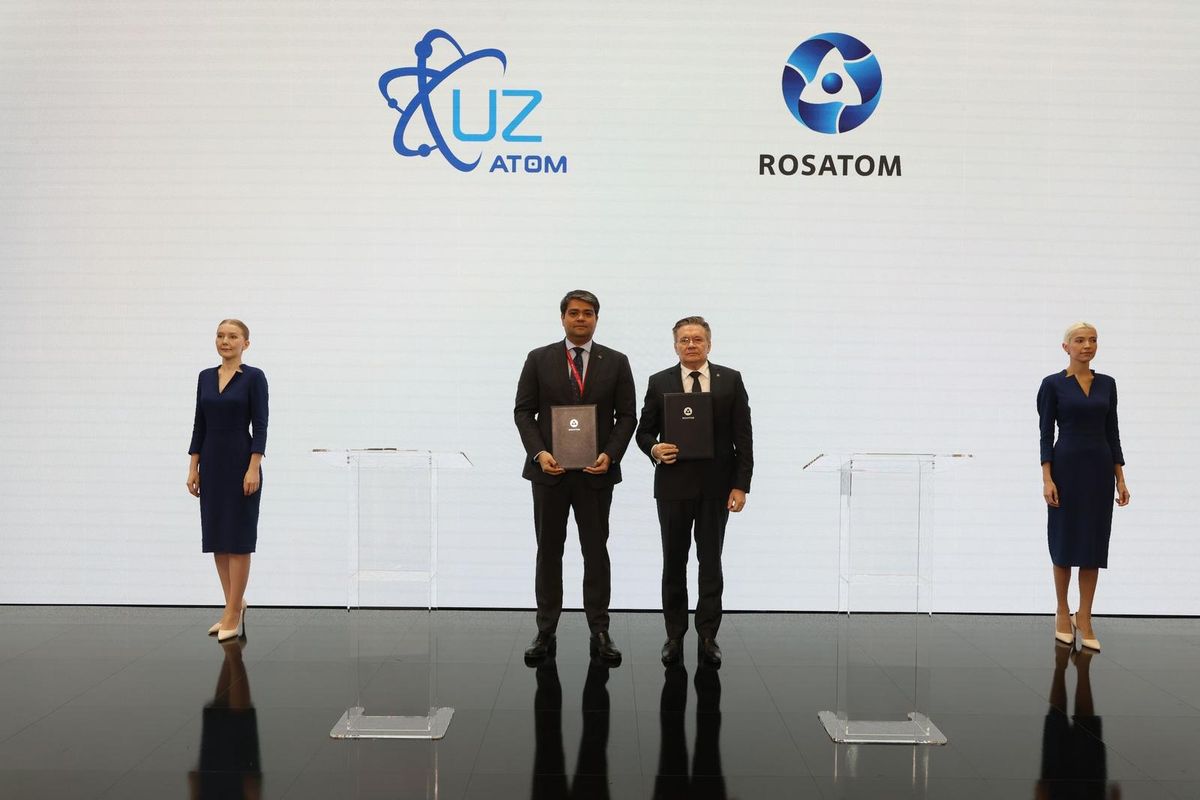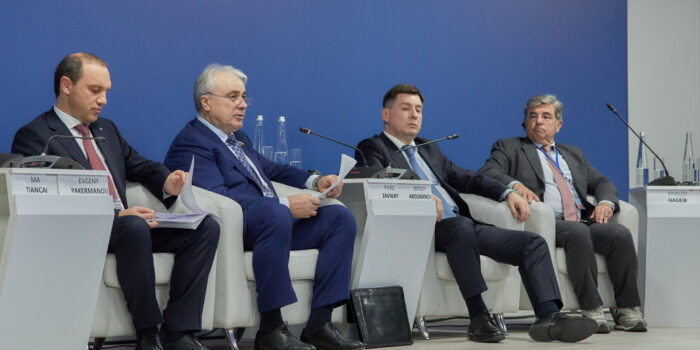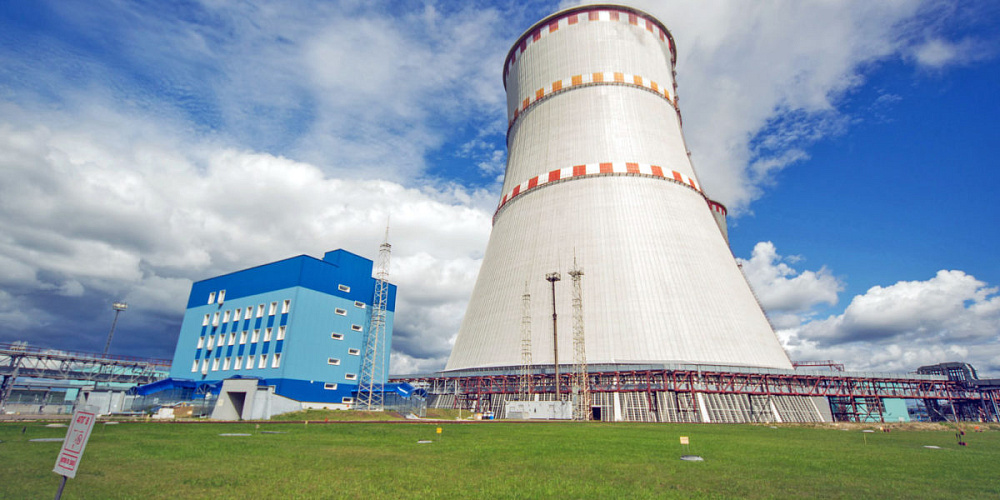On 20 June, on the sidelines
of the St. Petersburg International Economic Forum, the Atomic Energy Agency
under the Cabinet of Ministers of the Republic of Uzbekistan (Uzatom) and
Rosatom signed an agreement to study the possibilities of implementing a
project to construct a large nuclear power plant in the Republic of Uzbekistan.
The signing ceremony was attended by Azim Akhmedkhaidzhayev, Director of the
Atomic Energy Agency under the Cabinet of Ministers of the Republic of
Uzbekistan and Alexey Likhachev, Director General of Rosatom.
The agreement followed the arrangements made during the state visit of Russian President Vladimir Putin to Uzbekistan on 27 May 2024. At a meeting between Shavkat Mirziyoyev, President of the Republic of Uzbekistan, and Alexey Likhachev, Director General of Rosatom, held on the sidelines of the International Industrial Exhibition “INNOPROM. Central Asia” on 28April 2025 the Uzbek party announced its decision to build a large NPP. On 9 May 2025 during the visit of Shavkat Mirziyoyev, President of the Republic of Uzbekistan, to Vladimir Putin, President of the Russian Federation, the Uzbek party announced its decision to study the possibility of constructing a large NPP.
The document specifies the main terms and conditions for the potential implementation of the construction of two VVER-1000 power units with possible upgrade to four units. The project employs Russian technologies that have been proven to be reliable and safe both domestically and at foreign sites in China (Tianwan NPP) and India (Kudankulam NPP). So far, VVER-type reactors have been operating for more than 420 reactor years in total.
“Rosatom is pleased to be a strategic partner in Uzbekistan's nuclear energy development. We are expanding our collaboration: while we are continuing the construction of an SMR-based nuclear power plant in Jizzakh Oblast we are making a significant step forward to implement a project to construct an NPP with VVER-1000. SMR-based and large NPPs together can create a "carbon-free energy cluster" in Uzbekistan, provide a solution to the country's growing energy needs issue and lay the groundwork for industrial and innovative growth,” said Alexei Likhachev, Director General of Rosatom. Alexei Likhachev emphasized that Rosatom is actively involved in the construction of the SMR-based NPP and has already begun manufacturing reactor equipment for unit one.
“We consider the construction of a large-capacity nuclear power plant as a strategic step toward the creation of a reliable and balanced energy system capable of meeting both the current and future electricity demands of the country with environmentally friendly energy. The signing of the agreement enables the commencement of active work on developing the key conditions for the potential implementation of the large-capacity nuclear power plant project. A Joint Working Group has been established to examine the main aspects of the project and to conduct a cost assessment of its construction,” noted Mr. Akhmedkhadjaev Azim, Director of the Agency for Atomic Energy under the Cabinet of Ministers of the Republic of Uzbekistan.
Rosatom, is a diversified holding company that operates energy, mechanical engineering, and construction assets among others. Its strategy is to develop low-carbon energy generation, including wind power. Rosatom plays a leading role in electricity generation in Russia, accounting for approximately 20% of the total output. It is also the world's leader for its backlog of NPP construction orders with 39 units (including six small units) at various construction stages in 10 countries. In addition, Rosatom businesses include innovative non-nuclear products, logistics, the development of the Northern Sea Route and environmental projects. Rosatom comprises more than 450 companies and organizations, employing approximately 420,000 people.
On 27 May 2024, during the
state visit of Russian President Vladimir Putin to Uzbekistan, in the presence
of the leaders of Uzbekistan and Russia, a protocol was signed to amend the
intergovernmental agreement on cooperation in the construction of a nuclear
power plant in Uzbekistan. The amendments provide for cooperation in the
construction of a Russian-designed SMR-based NPP in Uzbekistan. After that, on
the sidelines of the event, Atomstroyexport Joint-Stock Company (Engineering
Division of Rosatom) and the Directorate for NPP Construction of the Atomic
Energy Agency under the Cabinet of Ministers of the Republic of Uzbekistan
signed a contract for the construction of an SMR-based NPP in Uzbekistan. The
project envisages the construction of a Russian-designed SMR-based NPP in the
Jizzakh Oblast in Uzbekistan. The plant with a total capacity of 330 megawatts
will have six reactors, with a capacity of 55 megawatts each.
The NPPs with VVER-1000 designed by Russian engineers are now successfully operating in several foreign countries. Specifically, the four power units operating at the Tianwan NPP in China have been recognized as the safest in the world based on several factors over years. The first two units at the Kudankulam NPP in India have already generated more than 100 billion kilowatt-hours of electricity for the nation's energy grid, demonstrating performance above the design standards.
On 13 May 2025, the Mechanical Engineering Division of Rosatom started the production of reactor equipment for the SMR-based NPP in Uzbekistan: a 205-ton ingot of special alloy steel was cast. This ingot will be used to create the future RITM-200 vessel.




